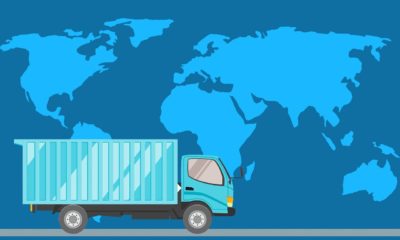Logistics & Transportation
Uber Has Given Its App A Broad Overhaul, Incorporating All Of Its Rides and Delivery Services In One App

Businessuite News24
India’s 10-Minute Delivery Boom: A Blueprint for Disruption—and a Wake-Up Call for Caribbean Courier Companies
While the Caribbean market differs significantly in terms of geography, population density, and infrastructure, India’s 10-minute delivery trend signals a major shift in consumer expectations and service standards that cannot be ignored. Caribbean courier and logistics companies must take this as a call to evolve or risk irrelevance.
Businessuite News24 International
India’s 10-Minute Delivery Boom: Reshaping Retail, Logistics, and Urban Spaces
India is witnessing a rapid and transformative shift in its retail and logistics sectors through the rise of quick-commerce (q-commerce)—a model that promises to deliver goods within 10 minutes. At the center of this boom are companies like Blinkit (owned by Zomato), Swiggy Instamart, Zepto, and Flipkart Minutes, which are racing to meet the increasing demand for ultra-fast delivery, not just in metropolitan areas but also in tier-2 and tier-3 cities.
Businessuite Markets
Mailpac Group Doubles Q1 Revenue to $716.4M, Driven by My Cart Express Integration
The Company delivered a strong performance for the first quarter of the financial year, with total revenues of $716.4 million, representing a 94% increase over the J$368.5 million reported for the corresponding period in 2024. This growth was primarily driven by the integration of My Cart Express in reporting.
Logistics & Transportation
Unilever Caribbean’s Strategic Shift: Embracing Outsourced Logistics for Enhanced Efficiency
UCL’s strategic move reflects a broader trend among Caribbean manufacturers and distributors. Companies like Nestlé Jamaica have similarly outsourced their logistics operations to focus on core business areas. This regional shift is influenced by the desire to improve efficiency, reduce costs, and leverage the expertise of specialized logistics providers
Businessuite News24
$420 Million Secured for Second CNG Plant at JUTC Spanish Town Depot
-

 Businessuite Markets2 weeks ago
Businessuite Markets2 weeks agoScotia Group Delivers 19% Q2 Profit Growth, Net Income Hits $5B for the Quarter
-

 Businessuite Markets4 weeks ago
Businessuite Markets4 weeks agoThe Strategic Importance of Investor Communication and Recommendations for Caribbean Listed Companies
-

 Logistics & Transportation4 weeks ago
Logistics & Transportation4 weeks agoUnilever Caribbean’s Strategic Shift: Embracing Outsourced Logistics for Enhanced Efficiency
-

 Leadership Conversations3 weeks ago
Leadership Conversations3 weeks agoWhy Some CEOs Resist the Concept of Buy-In
-

 Businessuite Markets4 weeks ago
Businessuite Markets4 weeks agoSpur Tree Spices Projects Growth from Product Innovation, Domestic Sales, and E-Commerce Scaling
-

 Businessuite Women5 days ago
Businessuite Women5 days agoDorothea Gordon-Smith Marks 50 Years of Quiet Power in Waste Management
-

 Businessuite Markets4 weeks ago
Businessuite Markets4 weeks agoMailpac Group Doubles Q1 Revenue to $716.4M, Driven by My Cart Express Integration
-

 Business Insights2 weeks ago
Business Insights2 weeks agoYou Can’t Fix What You Can’t See: Why Jamaica Broilers’ U.S. Collapse Wasn’t Just Financial, It Was Strategic














 Financial Performance: The Company delivered a strong performance for the first quarter of the financial year, with total revenues of $716.4 million, representing a 94% increase over the J$368.5 million reported for the corresponding period in 2024. This growth was primarily driven by the integration of My Cart Express in reporting. Gross profit for the quarter amounted to $388.7 million, compared to $197.9 million for the same period last year, reflecting improved margins and operational efficiencies. This improvement is attributed to increased operational efficiencies and negotiated cost reductions achieved through economies of scale. The Company recorded net profit of $69.7 million of Q1 2025, an increase from $50.1 million in Q1 2024, representing a 39% year-over-year increase. Strategic Developments and
Financial Performance: The Company delivered a strong performance for the first quarter of the financial year, with total revenues of $716.4 million, representing a 94% increase over the J$368.5 million reported for the corresponding period in 2024. This growth was primarily driven by the integration of My Cart Express in reporting. Gross profit for the quarter amounted to $388.7 million, compared to $197.9 million for the same period last year, reflecting improved margins and operational efficiencies. This improvement is attributed to increased operational efficiencies and negotiated cost reductions achieved through economies of scale. The Company recorded net profit of $69.7 million of Q1 2025, an increase from $50.1 million in Q1 2024, representing a 39% year-over-year increase. Strategic Developments and

 Unilever Caribbean Ltd (UCL) has recently approved a significant transformation in its distribution strategy by adopting a new route-to-market structure.
Unilever Caribbean Ltd (UCL) has recently approved a significant transformation in its distribution strategy by adopting a new route-to-market structure. UCL’s strategic move reflects a broader trend among Caribbean manufacturers and distributors.
UCL’s strategic move reflects a broader trend among Caribbean manufacturers and distributors.






